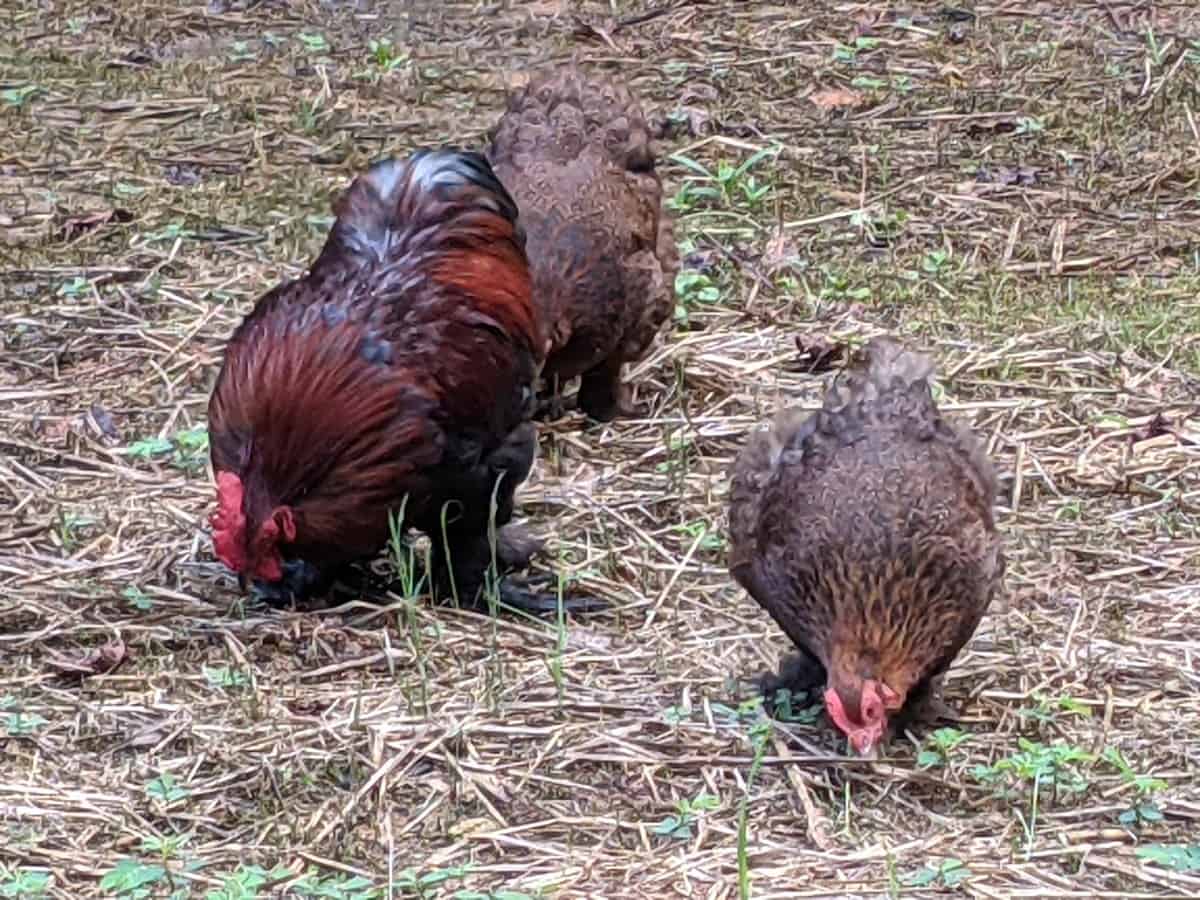If you keep backyard chickens, it can be confusing when it comes to what you will need to provide to keep them happy and healthy. One of the questions that come up concerns the use of chicken grit and oyster shell. Should you give your chickens extra oyster shells with their food?
A good rule of thumb is that even if they have access to small stones in a free-range yard, all adult chickens will need grit or gravel to grind their food in their gizzard. Grit will keep them healthy and helps them process their food into small digestible particles.
So, where do oyster shells come in? Well, oyster shells are an excellent and relatively inexpensive source of calcium that you will need to provide to your hens if they are laying eggs.
Backyard chickens will need oyster shells if they are laying hens. All chickens need grit, which is not the same as oyster shells. Grit is insoluble and helps chickens digest their food, but oyster shells are a soluble form of calcium. Hens need four times the amount of calcium when they are laying eggs.
If you keep a small flock of hens for backyard egg production, you will need to give them a source of calcium. Without enough calcium in their diet, hens will be prone to brittle bones and lay soft-shelled eggs. Without the correct minerals in a chicken diet, it will lead to ill health and distress.
Your chickens could be laying up to an egg a day, each containing 94-97% of calcium carbonate. That calcium has to come from your chicken, so you can see clearly why additional calcium in their feed is a must for happy chickens and beautiful egg colors.
- What is oyster shell?
- What Do Oyster Shells Do For Chickens?
- What Are The Signs My Chickens Need More Calcium
- How Much Oyster Shells Should I Give My Chickens
- How Often Should I Feed Chickens Oyster Shells
- How Do You Prepare Oyster Shells For Chickens
- What Are Alternatives To Oyster Shells For Chickens
- Do all chickens need oyster shell?
- Conclusion
What is oyster shell?
A reliable source of calcium for hens is oyster shell, which is the most popular and reliable food that can be given to them. Buying it from your feed store is far less expensive than buying it online (as well as much easier!).
Rather than buying a commercial product, some people use eggshells from their own chickens. It’s unlikely that a hen has enough calcium in her shell to supplement her vitamin needs if she already lacks it.
Including some oyster shell supplement along with eggshells is fine. You should bake your hens’ shells first to kill any bacteria before using them. After baking, crush it into small pieces before serving.
Despite this, oyster shell produced in a commercial setting is relatively inexpensive, long-lasting, and very effective. As a result, I recommend using that rather than your own eggshells. This product works great for my hens and I always have strong, healthy eggs.

What Do Oyster Shells Do For Chickens?
Oyster shells are a soluble form of gritty particles that provide your hens with a boost in calcium carbonate. They are made – as the name suggests – from oyster shells that have been ground down to the correct size.
Sometimes other shells may be used, but oyster shells provide the cheapest and best form of readily available calcium carbonate. As this gritty mix dissolves in your chicken’s gizzard, it releases necessary calcium and other trace minerals.
Chickens that are not laying will not need this extra calcium boost, but egg production uses extra calcium. If your hens do not get enough calcium from their diet and supplements, it will leave them with brittle bones, weaker immune systems, and soft-shelled eggs.
What Are The Signs My Chickens Need More Calcium
While good chicken feed usually contains additional supplements for general flock health, they don’t provide enough calcium for laying hens. It’s fairly easy to spot when your chickens need extra calcium.
- The earliest and easiest sign of low calcium in the diet is when laying hens produce eggs with soft shells. Proper amounts of oyster shells help produce hard-shelled eggs.
- Low egg production may be a sign that your hens need additional supplies of oyster shells. While egg laying will slow down for age or seasonal reasons, a sudden change may be a strong indication that you need to increase calcium supplies.
- Injuries and lameness may be indicators, as chickens with low calcium can easily break bones and have stiff joints. If your flock is suffering from repeated bone issues, you must supplement their diet with extra calcium.
- Sometimes unhealthy chickens will be more aggressive and fights among the flocks could signify low calcium supplies.
However, you may have also heard that it’s not a good idea to give your chickens too much calcium, so how will you know how much you should provide?
How Much Oyster Shells Should I Give My Chickens
Laying chickens are the only ones that will need extra calcium in their diets. There is no need to provide oyster shells or other sources of calcium carbonate to young hens—known as pullets —which have not started laying yet.
Chicks are far too young to need extra calcium, and because they are mainly fed soft foods, they will need small amounts of grit to help them digest as they grow.
Roosters will not need calcium, and if you have older hens in your flock who are past their egg-laying days, you will not need to put out crushed oyster shells for them.
Keep providing your chickens with crushed oyster shells all year round. Broody hens are ready to lay and will need the extra calcium, and those which are molting. Feather production also uses up calcium!
An excess of calcium can have some health complications, so if you have a mixed flock, it is best to set out a separate container or feeder of oyster shells rather than mixing it into the feed. This allows chickens to self-regulate.
They will eat only as much shell as they need when they are given the option. If you keep chickens for any time, you will know they are pretty savvy when it comes to what they want! Never confuse bird-brained with stupid.

How Often Should I Feed Chickens Oyster Shells
If you provide a constant source of calcium for your chickens year-round, there should be no issues. Crushed oyster shells should be made available in a separate bowl so that your hens can choose how much to take. Each day a hen will eat around 100 grams of feed, and about 4% of that will be calcium.
Chicken grit is essential for all chickens, but only around 30% of that grit will include oyster shells with the most commonly available brands. Some calcium and other soluble minerals will also come from their grit, which will be enough for non-laying chickens.
How Do You Prepare Oyster Shells For Chickens
Unless you’re lucky enough to live by a shoreline that has loads of oyster shells as I do, the easiest option is to buy commercial oyster shells. You can get some off of oyster shell off amazon.
While commercial oyster shell has already been crushed to small nuggets, some backyard chicken keepers find that the chunks are still too large. Their chickens may be unable to use these larger pieces of shell, and not get enough calcium.
One option is to buy flaked or fine-ground oyster shells, which may be more expensive.
If my oyster shells were still too big, I would crush them with a mallet. Using a food processor will likely burn out the motor, so I did not even attempt this, though I have seen it suggested as an option.
What Are Alternatives To Oyster Shells For Chickens
I’ve heard of some chicken owners who replace oyster shells with crushed eggshells. This can work, but you will need to cook the shells and grind them down to ensure they have no bacteria and are the correct size.
I am not a fan of this option for two reasons: if your hens already have a calcium deficiency, feeding them their own eggshells will not help, and training hens to eat eggshells could make them peck their own eggs. You do not want to encourage this behavior!
Some suppliers stock chicken food that is higher in calcium, but this may provide more calcium than you want for your chickens, especially if your flock is a mix of laying hens, pullets, chicks, and roosters.
For this reason, I also never mix my oyster shell into my chicken feed, even though some brands recommend this as an option.
If you do have the option to gather oyster shells, remember you will have to wash collected oyster shells to remove impurities and bake them to kill off any other bacteria and spores. To crush the cleaned and baked shells, place them in a heavy-duty feed sack or similar and hammer them into powder. It’s a great way to work out any frustration!
Do all chickens need oyster shell?
No, not at all. A chicken’s normal feed will provide enough calcium to those who aren’t laying eggs. When acting laying eggs, hens use four times the amount of calcium that a non-laying hen does. This is why egg-laying hens need additional calcium in their diets.
In addition, chickens that are not layers should not be given additional calcium. They may suffer kidney damage, which is potentially fatal. Dietary calcium is needed by laying hens.
Conclusion
It is relatively easy and inexpensive to supplement your backyard flock’s diet with additional calcium carbonate. Calcium is necessary to keep laying hens in good condition and to maintain healthy egg production.
Oyster shells crushed to size and placed in a separate feeder should provide them with everything they need. Keep an eye out for any signs of deficiencies or over-consumption, and regulate their supply as necessary.

